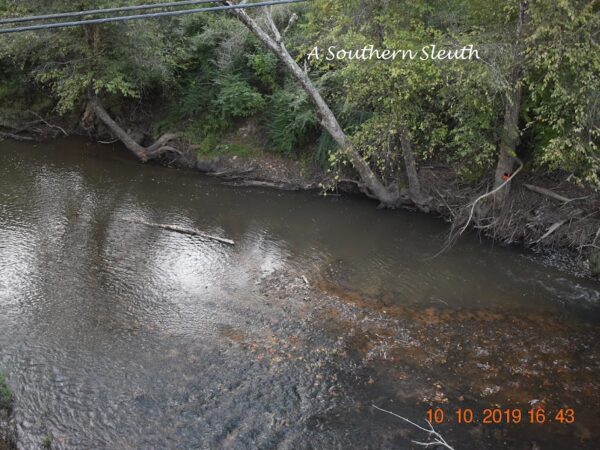| Grandsons learning to plow at a local living history farm |
A few years ago while visiting our daughter and her family on their farm in Central Washington, I rode along with one of the neighboring farmers in his tractor. I say “in” his tractor because it had an air conditioned cab, power steering and a satellite system that ensured the rows were perfectly straight. I was amazed at how farming has changed from the time I was a teenager and drove a tractor for my cousins as they baled hay.
Farming has changed even more since my ancestors’ day. Georgia farmers often used mules to pull their plows, or pushed them along themselves. For the small poor farmer, their help was often limited to what his family could provide. According to the agricultural digests, it doesn’t appear that John ever hired help on his farm, but lucky for him, he had five sons.
John was a typical Georgia farmer, planting most of his farm in cotton and corn. According to the 1880 Agricultural Census, John was the owner of a 40-acre farm, which included 18 acres of Indian corn, 2 acres of oats, 2 acres of wheat, and 18 acres of cotton. He also had 5 barnyard poultry, 8 swine and one milch cow in addition to one other cow. Cotton was considered one of the most profitable crops in the south and corn was the other commonly grown crop. Corn was needed for the farm animals and was a staple served at the southern table. It would be years before I realized that the corn pone and cornbread often served at my childhood dinner table in California was likely tied to my Southern roots.
In 1880, John and Olivia’s two oldest sons, William Franklin and John Thackason, were both married, had families and were farming just down the road. The three sons still at home who could help were Roderick Monroe who was 17, Newton Lafayette who was 13 and Robert Lee who was 10. I also know that for a period of time in 1882, John received some help from a Mormon missionary serving in the area. I am so thankful for the insight that the Elder John Metcalf’s journal provides.
According to Elder Metcalf’s journal, when he visited John ‘s home on May 19, 1882, he learned that a frost had killed some of John’s cotton and corn. Farmers have always been vulnerable to the unpredictability of the weather, but that didn’t softened the disappointment of such a loss. From what I know about John, he was never particularly well off, so I am sure that losing some of his crops came as a blow. The next morning, John got up and did the only thing that he could do and that was to get to work. Elder Metcalf recorded that the next day he helped John to plow, indicating that they plowed half a day and were so busy, he ended up staying the night in the Ganus home. A few days later, John had wheat to bind and Elder Metcalf returned to help. On July 28, Elder Metcalf helped John “plow cotton” and the men once again worked long and late into the evening.
As crops were harvested, a farmer was not yet “done,” as the fields had to be cleared and cleaned so that they would be ready in the spring for the new crop to be planted. On September 9th of that same year, Elder Metcalf found John in the field doing exactly that and once again, stepped in to help him.
The following day, September 10, it rained all day and Elder Metcalf recorded that consequently they just “waited it out”. I can almost picture the men, anxious to complete the task, periodically peering out the window for any indication of a break in the storm. The following day, the rain stopped and they were able to return to the field to continue their work. In my mind, I can see the steam rising from the field as the hot Georgia sun warmed the drenched soil. I also can imagine John and Elder Metcalf returning to John’s house at the end of the day, sunburned, tired and muddy from a full day’s work. For three back-breaking days, John and Elder Metcalf worked to clear the field.
September 14, Elder Metcalf helped John pull fodder. After harvesting corn, farmers had to “pull fodder”, which involves pulling the blades off of the cornstalks and gathering them into bunches to dry in the sun. The fodder was then stored to be fed to the cows later. It was difficult work and the sharp edges of the corn blades often sliced their hands in the process.
 |
| Sugar Cane |
According to the journal, John raised sugar cane that year and Elder Metcalf was there to help John cut the cane on September 28th, 29th and 30th and again on October 2nd, and 3rd. Cutting sugar cane was also difficult work, requiring that each stalk be cut individually from the ground and then at the top, after stripping off the foliage along the sides.3
As they came to the end of the growing season, John Metcalf returned to John’s farm one final time on October 31 to help John “pull and haul corn.”
While Elder Metcalf continued to visit John’s home, no further mention was made that year of helping him on the farm. For the next few months, John would take a brief break from working the soil but would continue to feed and care for his handful of livestock until the following spring, when he would once again begin the process of plowing, planting, and harvesting.
1. Selected U.S. Federal Census Non-Population Schedules, 1850-1880 database, Ancestry.com (http://www.ancestry.com : accessed 20 May 2013, entry for John M. Ganus, District 1143 Haralson, Georgia; Archive Collection Number: T1137; Page: 08; Line 10
2 Journal of John Edward Metcalf, Mission to the Southern States. No longer available on the internet. (bulk of material for this post was taken from entries in this journal).
3 Cultivation of Sugar Cane; William Carter Stubbs; Daniel Gugel Purse, Savannah, Morning News Print, 1900, page 144, found on www.books.google.com
Pictures from Wikipedia Commons, all in Public Domain.
Copyright © Michelle G. Taggart 2017, All rights reserved





That journal is a treasure, so helpful in filling in details about your ancestor John's daily life on the farm. Really enjoyed this post!
It's been an amazing blessing. It really helped me to learn so many personal things about John as well and has helped me in being able to share his story. I wish I had something comparable for all of my ancestors!
Oh my goodness, what a find that journal is. I had to laugh at the description of that modern tractor. I don't think my cousin has a tractor that advanced but he does have robots that feed his cows (it's a dairy farm) their food and supplements, programmed to feed each animal as prescribed. I wonder what his grandfather would have thought of that!
The journal is absolutely wonderful. I was so amazed at that tractor and had no idea they came that nice. Robots feeding cows??? I had no idea about that either. Imagine how much less time is spent as a result!
Michelle, I continue to learn a lot from your writing about this journal – ideas on how to convert knowledge into interesting narrative. Thanks so much for this gift!
Thank you for your kind words John. Hope all is well at your home.
Wow! What a lucky find, if only there was a John Metcalf for all our families! I'm enjoying your series on the life of John Ganus.
Your descriptions imagining the men at work bring this story to life.
Wouldn't that be great Dara? It would help us so much.
Thank you Wendy!
Hi Michelle,
Just catching up with John's story this evening. What a great find in that journal. I have something similar for my husband's side of the family. A local citizen who kept a journal, that was later published. Interesting entries about every day life, what the weather was, how much wood was chopped, what home this person went to for dinner. As family historians we can't get enough of those mundane entries that tell us of every day life way back when.
Loving this journey with John.
What a treasure Diane. You are so right, those details everyone else things are insignificant are just what we hunger for!